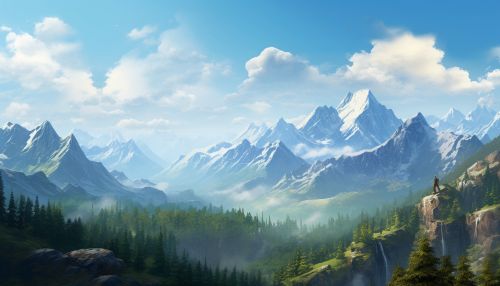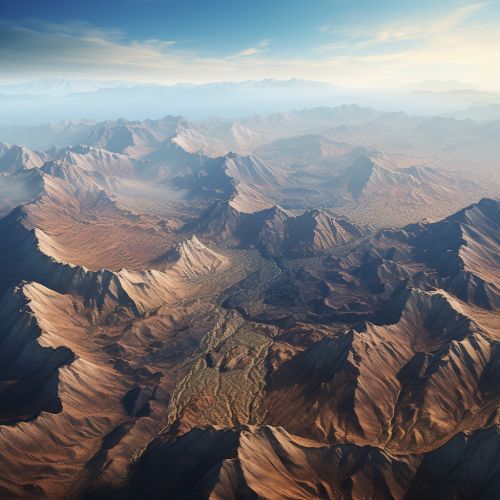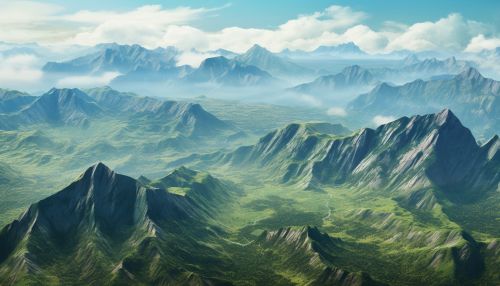The Dynamics of Mountain Building and Orogeny
Introduction
Mountain building, also known as orogeny, is a geological process resulting from the large-scale and complex structural deformation of the Earth's lithosphere due to the engagement of tectonic plates. This process often results in the formation of long linear structures known as mountain ranges. The study of these processes and the resulting formations is a significant part of structural geology and plate tectonics.


Tectonic Processes and Mountain Building
The primary driving force behind mountain building is plate tectonics, a theory that explains the large-scale motion of the Earth's lithosphere. This theory suggests that the Earth's outer shell, or lithosphere, is broken into several large and small pieces known as tectonic plates. These plates are constantly moving, albeit very slowly, and their interactions at their boundaries can lead to the formation of mountains, among other geological features.
Plate Boundaries and Orogeny
There are three main types of plate boundaries: convergent, divergent, and transform. Each of these can contribute to orogeny in different ways.
Convergent boundaries occur when two plates move towards each other, resulting in one plate being forced beneath the other in a process known as subduction. This can lead to the formation of mountain ranges, such as the Andes in South America or the Himalayas in Asia, which are formed by the subduction of the Nazca and Indian plates respectively beneath the South American and Eurasian plates.
Divergent boundaries occur when two plates move away from each other, creating a gap where magma rises to form new crust. This process can lead to the formation of mid-ocean ridges, such as the Mid-Atlantic Ridge. While these are technically underwater mountain ranges, they are generally not associated with the classic image of towering, jagged peaks.
Transform boundaries occur when two plates slide past each other horizontally. While these do not typically result in the formation of mountains, they can lead to significant seismic activity, as seen along the San Andreas Fault in California.
Orogenic Belts
Orogenic belts are the result of orogeny and are typically characterized by a series of parallel linear structures, such as mountain ranges, deep valleys, and plateaus. These belts are often associated with the presence of various types of rocks, including metamorphic, igneous, and sedimentary rocks.


Types of Orogenic Belts
There are two main types of orogenic belts: Cordilleran and Alpine.
Cordilleran orogeny is associated with subduction zones and the formation of volcanic mountain ranges, such as the Andes and the North American Cordillera. These orogenic belts are typically wide and contain a variety of rock types, including volcanic, sedimentary, and metamorphic rocks.
Alpine orogeny, on the other hand, is associated with the collision of two continental plates, leading to the formation of non-volcanic mountain ranges, such as the Himalayas and the Alps. These orogenic belts are typically narrower and are characterized by the presence of highly deformed and metamorphosed rocks.
Orogenic Processes
Orogeny involves a variety of processes that work together to deform the lithosphere and form mountains. These processes include folding, faulting, and metamorphism, among others.
Folding
Folding is a process by which rock layers are bent and deformed under pressure. This can result in the formation of anticlines, which are upward folds, and synclines, which are downward folds. These structures can be seen in many mountain ranges and are often visible in road cuts or exposed cliff faces.
Faulting
Faulting occurs when the stress on a rock layer exceeds its internal strength, causing it to fracture and the blocks on either side of the fracture to move relative to each other. There are several types of faults, including normal faults, reverse faults, and strike-slip faults, each of which can contribute to the formation of mountains in different ways.
Metamorphism
Metamorphism is the process by which existing rocks are transformed into new rock types due to changes in temperature, pressure, or the chemical environment. This process can result in the formation of metamorphic rocks, such as schist, gneiss, and marble, which are often found in mountainous regions.
Conclusion
Mountain building is a complex process that involves a variety of geological processes and structures. It is driven by the movement of tectonic plates and can result in the formation of stunning and diverse landscapes. Understanding these processes is crucial for understanding the Earth's past, predicting future geological events, and appreciating the natural beauty of our planet.
